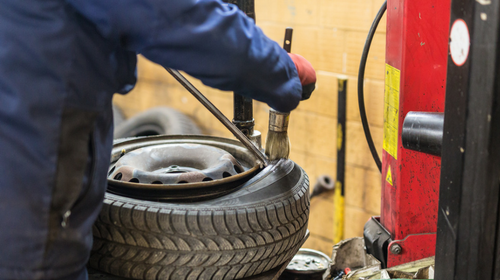
06/12/2017
New UNI Standard number 11691: “Tyre demounting and mounting machines for vehicles - Safety requirements”.
Donaldo Labò
Technical standardization has always been the result of voluntary cooperation between the industry, private companies, public administrators and consumers through a regulated process that provides operators with a precise framework of standards to define state-of-the-art products, processes and services.
On October 31, 2017, the new UNI 11691 standard was published, thus becoming part of the national regulatory body, highlighting safety requirements and inspection procedures in designing and producing machines for tire mounting and demounting operations, in order to ensure the best and safest tire assembly procedures.
Developed under CUNA’s oversight (Automotive Technical Unification Commission, and part of UNI – Italian National Unification Body) the new UNI 11691 Standard highlights safety requirements and inspection procedures in designing and producing machines for tire mounting and demounting operations, in order to ensure the best and safest tire assembly procedures.
In defining the specific safety requirements for these machines, all possible dangers are addressed, including potentially dangerous situations or circumstances where the equipment is used not as specifically instructed by the manufacturer or under conditions of reasonably foreseeable improper use (principles of the Machinery Directive), defining the appropriate technical measures to be adopted to reduce or eliminate risks during transport, work and maintenance. This is a type-C standard, as defined within the EN ISO 12100-1: 2010. When type-C standards differ from what is indicated in standards A or B, type-C standards take precedence over the others.
The field of application clearly specifies that it refers to mounting and demounting tires for vehicles belonging to following the international categories: M1, M2, N1, O1, O2, L4 and L5, i.e. cars, buses, lorries, motor-homes, trailers up to a total mass of 3.5 t, in addition to industrial trolleys, quads, motorcycles, mopeds and agricultural machines, where the dimensions of the tires are compatible with the maximum dimensions indicated in the tire changer’s user manual. The standard does not apply to vehicles built before the publication.
In the Definitions chapter, the term “specialist” confirms what already reported in other technical standards, i.e. "a person qualified to perform the operation and working for an enterprise qualified to carry out such an activity". The following chapters deal with a list of potential dangers: mechanical, electrical, noise, ergonomics, etc. as well as the consequent safety requirements and / or protection measures, from control devices (types and positions) to protections and integrative measures. The chapter "instructions for use" recalls that these constitute an integral part of the machine, in terms of markings, operating instructions, specific guidelines for mounting / demounting operations. Appendix A, B and C – circular letters - deal with machine types, control device protections against accidental actuations, pictograms to be used on machines and instructions for use, while Appendix D - regulation - provide instructions for UHP (Ultra High Performance) and RFT (Run Flat Tire) mounting/demounting operations. The Machinery Directive currently in force - 2006/42/EC - lists the contents of the EC Declaration of Conformity of any piece of equipment or machinery.
Point 8, in particular, specifies that, if necessary, reference can be made to other technical standards and specifications. Where all requirements have been implemented right from the design phase, and is therefore considered compliant with the new standard, it is possible to add the caption "technical standards and specifications used: UNI 11691 October 2017".
Developed under CUNA’s oversight (Automotive Technical Unification Commission, and part of UNI – Italian National Unification Body) the new UNI 11691 Standard highlights safety requirements and inspection procedures in designing and producing machines for tire mounting and demounting operations, in order to ensure the best and safest tire assembly procedures.
In defining the specific safety requirements for these machines, all possible dangers are addressed, including potentially dangerous situations or circumstances where the equipment is used not as specifically instructed by the manufacturer or under conditions of reasonably foreseeable improper use (principles of the Machinery Directive), defining the appropriate technical measures to be adopted to reduce or eliminate risks during transport, work and maintenance. This is a type-C standard, as defined within the EN ISO 12100-1: 2010. When type-C standards differ from what is indicated in standards A or B, type-C standards take precedence over the others.
The field of application clearly specifies that it refers to mounting and demounting tires for vehicles belonging to following the international categories: M1, M2, N1, O1, O2, L4 and L5, i.e. cars, buses, lorries, motor-homes, trailers up to a total mass of 3.5 t, in addition to industrial trolleys, quads, motorcycles, mopeds and agricultural machines, where the dimensions of the tires are compatible with the maximum dimensions indicated in the tire changer’s user manual. The standard does not apply to vehicles built before the publication.
In the Definitions chapter, the term “specialist” confirms what already reported in other technical standards, i.e. "a person qualified to perform the operation and working for an enterprise qualified to carry out such an activity". The following chapters deal with a list of potential dangers: mechanical, electrical, noise, ergonomics, etc. as well as the consequent safety requirements and / or protection measures, from control devices (types and positions) to protections and integrative measures. The chapter "instructions for use" recalls that these constitute an integral part of the machine, in terms of markings, operating instructions, specific guidelines for mounting / demounting operations. Appendix A, B and C – circular letters - deal with machine types, control device protections against accidental actuations, pictograms to be used on machines and instructions for use, while Appendix D - regulation - provide instructions for UHP (Ultra High Performance) and RFT (Run Flat Tire) mounting/demounting operations. The Machinery Directive currently in force - 2006/42/EC - lists the contents of the EC Declaration of Conformity of any piece of equipment or machinery.
Point 8, in particular, specifies that, if necessary, reference can be made to other technical standards and specifications. Where all requirements have been implemented right from the design phase, and is therefore considered compliant with the new standard, it is possible to add the caption "technical standards and specifications used: UNI 11691 October 2017".






